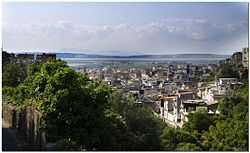Lentini
| Lentini | ||
|---|---|---|
| Comune | ||
| Comune di Lentini | ||
 | ||
| ||
 Lentini | ||
| Coordinates: 37°17′N 15°00′E / 37.283°N 15.000°E | ||
| Country | Italy | |
| Region | Sicily | |
| Province | Syracuse (SR) | |
| Government | ||
| • Mayor | Alfio Mangiameli (PD) | |
| Area | ||
| • Total | 215.75 km2 (83.30 sq mi) | |
| Elevation | 53 m (174 ft) | |
| Population (1 January 2008) | ||
| • Total | 24,093 | |
| • Density | 110/km2 (290/sq mi) | |
| Demonym | Lentinesi | |
| Time zone | CET (UTC+1) | |
| • Summer (DST) | CEST (UTC+2) | |
| Postal code | 96016 | |
| Dialing code | 095 | |
| Patron saint | Sant'Alfio | |
| Saint day | May 10 | |
| Website | Official website | |

Lentini (Sicilian: Lintini), historically Leontini, Leontinoi (Ancient Greek: Λεοντῖνοι), or Leontium, is a town and comune in the Province of Syracuse, southeast Sicily (southern Italy).
History
The ancient city was founded as Leontini by colonists from Naxos in 729 BC, itself a Chalcidian colony established five years earlier.
It is virtually the only Greek settlement in Sicily not located on the coast, being some 6 miles inland. The site, originally held by the Sicels, was seized by the Greeks owing to its command of the fertile plain to the north. The city was reduced to subject status in 498 BC by Hippocrates of Gela, who made his ally Aenesidemus its tyrant.[1] In 476 BC Hieron of Syracuse moved the inhabitants from Catana and Naxos to Leontini.
Later on, the city of Leontini regained its independence. However, as part of the inhabitants' efforts to retain that independence, they sought the intervention of Athens. It was mainly the eloquence of Gorgias of Leontini which led to the abortive Athenian expedition of 427 BC.
In 422 BC Syracuse supported the oligarchs against the people and received the oligarchs as citizens, the city of Leontini itself being forsaken. This led to renewed Athenian intervention, at first mainly diplomatic; but the exiles of Leontini joined the envoys of Segesta, in persuading Athens to undertake the great Sicilian Expedition of 415 BC.
After the failure of the Expedition, Leontini became subject to Syracuse once more.[2] The city's independence was guaranteed by the treaty of 405 BC between Dionysius and the Carthaginians, but lost again shortly after. The city was finally stormed by Marcus Claudius Marcellus in 214 BC.
By Roman times it seems to have been of little importance. It was destroyed by the Saracens in 848 AD, and almost totally ruined by the earthquake of 1693. From the earthquake to about the middle of the 20th century, Lentini was regarded by travel writers as a malarial stop-over to Syracuse of minor historical importance.
The ancient city is described by Polybius [3] as lying in a valley between two hills, and facing north. On the western side of this valley ran a river with a row of houses on its western bank under the hill. At each end was a gate, the northern gate leading to the plain, the southern, at the upper end, leading to Syracuse. There was an acropolis on each side of the valley, lying between precipitous hills with flat tops, over which buildings had extended. The eastern hill still has the remains of a strongly fortified medieval castle, in which some writers are inclined (though wrongly) to recognize portions of Greek masonry.
Excavations were made in 1899 in one of the ravines in a Sicel necropolis of the third period—explorations in the various Greek cemeteries resulted in the discovery of some fine bronzes, notably a fine bronze lebes, now in the Berlin museum.
Main sights
Lentini's main monuments include:
- The Baroque Chiesa Madre Santa Maria la Cava e Sant'Alfio ("Mother Church of St. Mary of the Pit and St. Alphius"), built in 1693 by Vella da Malta. It has a basilica plan with a nave and two aisles; the three-orders façade is from the 18th century. Noteworthy is the central portal with scenes of the martyrdoms of St. Alfio, Filadelphus and Cirinus. The interior houses a Byzantine icon from the 12th century.
- The church of the Santissima Trinità and San Marziano. It was built over the 16th century Palazzo La Palumba. It has a noteworthy pavement in ceramics of Caltagirone (18th century), a polyptych of Antonello da Messina's school and the high altar tabernacle in lapislazuli.
- Church of the Immacolata (17th century). The interior is home to a Romanesque lion sculpture, a Christ at the Column and the tombstone of Queen Marie (1402).
- The Church of St. Luke. It has a notable San Francis Speaking by Jacopo Bassano and other artworks. Next to the church are the remains of the Castle of Frederick II, the hypogeum of St. Lucy with 14th-century frescoes, the Crucifix Grottoes with frescoes from the 12th-17th centuries and the ruins of the old parish church of St. Peter (16th century).
- The 18th-century church of San Francesco di Paola, with a rare organ and artworks from churches destroyed by the 1693 earthquake.
Economy
Lentini's economy is mostly based on agriculture, with also a rather flourishing woodcraft and handicraft production.
Notable Lentinesi
Gorgias, Pre-Socratic philosopher (c. 485 – c. 380 BCE)
Giacomo da Lentini, thirteenth-century poet and reputed inventor of the sonnet.
Filadelfo Mugnos (1607–1675), man of letters and author of the Teatro genealogico delle famiglie nobili siciliane.
References
 This article incorporates text from a publication now in the public domain: Chisholm, Hugh, ed. (1911). Encyclopædia Britannica (11th ed.). Cambridge University Press
This article incorporates text from a publication now in the public domain: Chisholm, Hugh, ed. (1911). Encyclopædia Britannica (11th ed.). Cambridge University Press- Valenti, F. (2007). Leontinoi, storia della città. Palermo.
